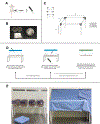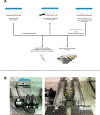Measuring Skeletal Muscle Thermogenesis in Mice and Rats
- PMID: 35969093
- PMCID: PMC9969793
- DOI: 10.3791/64264
Measuring Skeletal Muscle Thermogenesis in Mice and Rats
Abstract
Skeletal muscle thermogenesis provides a potential avenue for better understanding metabolic homeostasis and the mechanisms underlying energy expenditure. Surprisingly little evidence is available to link the neural, myocellular, and molecular mechanisms of thermogenesis directly to measurable changes in muscle temperature. This paper describes a method in which temperature transponders are utilized to retrieve direct measurements of mouse and rat skeletal muscle temperature. Remote transponders are surgically implanted within the muscle of mice and rats, and the animals are given time to recover. Mice and rats must then be repeatedly habituated to the testing environment and procedure. Changes in muscle temperature are measured in response to pharmacological or contextual stimuli in the home cage. Muscle temperature can also be measured during prescribed physical activity (i.e., treadmill walking at a constant speed) to factor out changes in activity as contributors to the changes in muscle temperature induced by these stimuli. This method has been successfully used to elucidate mechanisms underlying muscle thermogenic control at the level of the brain, sympathetic nervous system, and skeletal muscle. Provided are demonstrations of this success using predator odor (PO; ferret odor) as a contextual stimulus and injections of oxytocin (Oxt) as a pharmacological stimulus, where predator odor induces muscle thermogenesis, and Oxt suppresses muscle temperature. Thus, these datasets display the efficacy of this method in detecting rapid changes in muscle temperature.
Conflict of interest statement
Disclosures
The authors declare that they have no conflicts of interest.
Figures






Similar articles
-
Skeletal muscle thermogenesis induction by exposure to predator odor.J Exp Biol. 2020 Apr 16;223(Pt 8):jeb218479. doi: 10.1242/jeb.218479. J Exp Biol. 2020. PMID: 32165434 Free PMC article.
-
Exposure to predator threat engages sympathetic nervous system outflow to skeletal muscle.Auton Neurosci. 2025 Aug;260:103304. doi: 10.1016/j.autneu.2025.103304. Epub 2025 Jun 1. Auton Neurosci. 2025. PMID: 40494254
-
Suppressed sympathetic outflow to skeletal muscle, muscle thermogenesis, and activity energy expenditure with calorie restriction.Physiol Rep. 2017 Feb;5(4):e13171. doi: 10.14814/phy2.13171. Epub 2017 Feb 27. Physiol Rep. 2017. PMID: 28242830 Free PMC article.
-
Exercise in a pill: feasibility of energy expenditure targets.Curr Drug Targets CNS Neurol Disord. 2004 Oct;3(5):389-409. doi: 10.2174/1568007043337076. Curr Drug Targets CNS Neurol Disord. 2004. PMID: 15544447 Review.
-
Adipose and skeletal muscle thermogenesis: studies from large animals.J Endocrinol. 2018 Jun;237(3):R99-R115. doi: 10.1530/JOE-18-0090. J Endocrinol. 2018. PMID: 29703782 Review.
Cited by
-
Systematic review: pain, cognition, and cardioprotection-unpacking oxytocin's contributions in a sport context.Front Physiol. 2024 Jun 10;15:1393497. doi: 10.3389/fphys.2024.1393497. eCollection 2024. Front Physiol. 2024. PMID: 38915776 Free PMC article.
-
Chemogenetic Excitation of Ventromedial Hypothalamic Steroidogenic Factor 1 (SF1) Neurons Increases Muscle Thermogenesis in Mice.Biomolecules. 2024 Jul 9;14(7):821. doi: 10.3390/biom14070821. Biomolecules. 2024. PMID: 39062535 Free PMC article.
-
Reduced contextually induced muscle thermogenesis in rats with calorie restriction and lower aerobic fitness but not monogenic obesity.Temperature (Austin). 2023 Feb 6;10(3):379-393. doi: 10.1080/23328940.2023.2171669. eCollection 2023. Temperature (Austin). 2023. PMID: 37554387 Free PMC article.
References
Publication types
MeSH terms
Grants and funding
LinkOut - more resources
Full Text Sources
